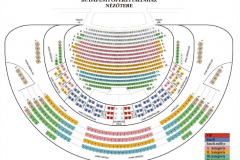Fiddler on the Roof
February 2026 | ||||||
|---|---|---|---|---|---|---|
Mo | Tu | We | Th | Fr | Sa | Su |
"A fiddler on the roof… you might say every one of us is a fiddler on the roof, trying to scratch out a pleasant, simple tune without breaking his neck. It isn’t easy."
The setting is Anatevka, a village inhabited by Jews and Russians in the 20th century, where the life of the community is defined by religion and all-encompassing traditions. Tevye, the milkman, lives here with his wife Golde and their five daughters. The father does everything in his power to keep the family together and marry off his daughters according to tradition. However, the young girls want to marry out of love instead of religious ideals. The eldest daughter, Tzeitel, chooses the poor tailor Motel over a wealthy suitor, Hodel, her sister, travels to Siberia to be with her imprisoned love, Perchik, and the third daughter, Chava, finds happiness with a boy from another religion. Meanwhile, the local Jewish community faces various hardships, including rising anti-Semitism, political demonstrations, and ultimately a decree to leave their ancestral land and abandon their wealth.
The play was first performed in Hungary at the Operetta Theatre on February 9, 1973, directed by László Vámos and starring Ferenc Bessenyei. This work holds great significance, as it bridges the genres of operetta and musical, captivating audiences with its unique musical style and bittersweet humour. The play was banned in 1974 and was only performed again eleven years later, in 1985, also at the Operetta Theatre.
In 2021, it returns to our repertoire, directed by Yvette Bozsik and with the collaboration of all the artists of the theatre!
Please note that due to the production's special set design, the English subtitles are visible only to a limited extent from the upstairs seats. Please consider this when purchasing your tickets.
Program and cast
Creators
Joseph Stein: Írta
Jerry Bock: Zene
Sheldon Harnick: Versek
Orbán János Dénes: Translator
Pfeiffer Gyula: Musical director
Mónika Szabó: Conductor of choir
Zsuzsanna Németh: Assistant choreographer
Bea Nagy: Assistant director
András Tucker: Artistic assistant
József Dreiszker: Light designer
Berzsenyi Krisztina: Costume designer
Boros Anna Eszter: Díszlettervező asszisztens
Khell Zsolt: Set designer
Krizsán Dániel: Koreográfus munkatárs
Gombai Szabolcs: Koreográfus munkatárs
Yvette Bozsik: Rendező - koreográfus
Cast
Tamás Földes: Tevje, a tejesember
Zsuzsa Kalocsai: Golde, Tevje felesége
Vanya Noémi: Cejtel, Tevje lánya
Széles Flóra: Hódel, Tevje lánya
Kelemen Fanni: Háva, Tevje lánya
Szalay Ágnes (e.h. SZFE): Sprince, Tevje lánya
Árki Lili Katalin (e.h. SZFE): Bjelke, Tevje lánya
Marika Oszvald: Jente, házasságközvetítő
Dénes Kocsis: Mótel Kamzolj, szabólegény
Lóránt Nagy: Percsik, diák
Zoltán Kiss: Lejzer-Wolf, hentes
Attila Balogh-Bodor: Mordche, kocsmáros
László Csere: Rabbi
Roland Imre: Mendel, a Rabbi fia
Balázs Angler: Avram, könyvárus
Gombai Szabolcs: Náhum, koldus
Zsuzsa Ullmann: Cejtel dédi, Golde nagyanyja
Veronika Nádasi: Fruma-Sára
Attila Miklós: Csendbiztos
Wéber Tamás Bence: Fegyka
Ildikó Sz. Nagy: Sejndl, Mótel anyja
Erdős Attila: Szása - Első orosz
Ákos Czeglédi: Jásszl, a kalapos
Kiss-Balbinat Ádám: A hegedűs
Budapest Operetta Theater
History
The history of the Operetta Theatre begins with the name of Károly Somossy who used to run an Orpheum in the building at 17 Nagymező street since 1884. In 1890 he bought the house and had it transformed into an entertainment house by the Felner and Helmer company, which opened in 1894. Its interior design was exalted by all accounts. Then the venture went bankrupt in 1899, Károly Albrech restaurant keeper took over the operation and from 1902 a Variety Show started to work there with the name of Fővárosi Orfeum, under the management of Imre Waldmann.
The Americal theatre entrepreneur, Ben Blumenthal, after having purchased the Vígszínházm also rented the Orpheum in 1922. The refurbished theatre opened its gates on 23 December 1922 first as Fővárosi Színház, a year later taking up the name of Fővárosi Operett Színház.
From 1929 to 1930 the Fővárosi Művész Színház (Arts Theatre) worked there with leadership of Gyula Kabos. From September 1930 the theatre took up again its old name and was lead by Dezső Sebestyén but it was forced to close several times because of the scanty attendance. From 1936 to 1938 it hosted the Arts Theatre of Artúr Bárdos.
After the siege of Budapest the theatre was opened in march 1945 with the popular operetta by Imre Kálmá, the Csárdáskirálynő. This soon became the biggest Hungarian and international success of the play. The theatre was nationalized in 1949, and Margit Gáspár appointed as director. The general renovation of the building had already been decided in 1960 but it was only realized in the second part of the sixties. In 1966 the company moved into the former building of the Petőfi Theatre, and the reconstruction started according to the plans of the Középüettervező Vállalat (Company of Public Constructions). The designers were: Halmi Iván, Pozsay Csaba és Vajda Ferenc. The festive opening was held on 17 April 1971, again with a staging of Csárdáskirálynő. This was the thousandth performance of Imre Kálmán’s operetta.
Imre Halasi, who used to be the manager of the theatre from 1996 to 2000, changed the name of the theatre form 1. January 1998. Since then it is called Budapesti Operettszínház (Budapest Operetta Theatre). Another reconstruction of the building can be tied to the name of Halasi, the aim of which was the restoration of the original milieu. The designer, Mária Siklós, tried to free the building from the construction errors that got there during the several earlier reconstruction.
In March 2002 a studio theatre for 100 people was inaugurated, the so called Storage Room Theatre situated in the theatre’s wing in Mozsár street.
Architectural description
The unique character the theatre comes from the interesting features of the plot division. The main facade and the entrance of the Budapest Operetta Theatre opens from the Nagymező Street, however the functions of the theatre are built in to the inside courtyards framed by houses between the Andrássy, Nagymező and Mozsár streets. Therefore the mass of the auditorium and the flyloft is not perceptible from the street.
The two-storey mass of the main facade was built at the turn of the century, according to the plans of the famous Viennese theatre designer duo, Ferdinand Fellner and Herman Helmer. The entrance axe is surrounded at the entire height of the building by arched closed pediment. The entrance projection is articulated with two opening axes. The windows on the first floor are squared closed, while those on the second floor are arched. On the attics closing this part of the building on the complete with of the projection stands a lyre indicating the function of the building.
The side wings are articulated with three opening axes and pilasters, which surround the first and second floors. Between the ground and first floor a dividing edge and balusters run around. The first floor openings are arched, while those on the second floor are squared, closed with decorative frame and keystone. The ground floor surface is horizontally pointed. The wall plane of the storeys is punch coloured; the pilasters, the sides, the ornaments and the window frames are white.
The auditorium is fan-shaped with balconies on the first and second floor. The stage is framed with accented proscenium wall and proscenium boxes.

 EN
EN DE
DE IT
IT FR
FR ES
ES RU
RU JP
JP RO
RO
 Seating plan
Seating plan 